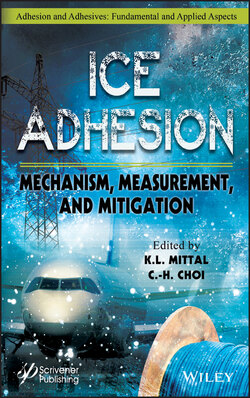Читать книгу Ice Adhesion - Группа авторов - Страница 16
1.2.1 Homogeneous Classical Nucleation Theory
ОглавлениеThe Classical Nucleation Theory models a growing ice embryo of clustered H20 molecules as a sphere of radius re, as shown in Figure 1.3(a). The change in free energy of a liquid water system due to spherical ice embryo growth is a result of the competing energy effects of: (i) creating a new lower energy (solid) phase, and (ii) creating a new higher energy (solid-liquid) interface. The balance of these energy terms is given in Equation 1.1.
where ∆GIW(T) and γIW(T) denote the free energy difference between ice and water (per unit volume) and the interfacial energy between ice and water (per unit area), respectively. The first term in Equation 1.1 quantifies the decrease in free energy of the volume occupied by the ice embryo when the phase changes from liquid to solid, whereas the second term quantifies the increased contribution of the newly formed interface. At low embryo radii, the interfacial energy term dominates. Conversely, at higher ice embryo radii, the volume energy term dominates. The balance between interfacial and volume energy change during ice embryo growth is shown schematically in Figure 1.3(b).
Figure 1.3(b) shows how the balance between interfacial and volume energy change yields a local maximum in Gibbs free energy, ∆G*. Therefore, it is energetically favourable for ice embryos with radii less than some critical radius, , to decay back into the liquid phase, while those with radii greater than are energetically favoured to continue on to the growth phase. The critical ice embryo radius can thus be calculated from Equation 1.2.
Figure 1.3 (a) The Classical Nucleation Theory models a growing embryo of clustered molecules for the new thermodynamic phase as a sphere of radius re. (b) Schematic representation of the free energy associated with the growth of the embryo due to the interfacial energy and volume energy. ∆G* and are the free energy barrier for continued nucleus growth and critical nucleus radius, respectively.
Determination of a critical ice embryo radius for a given temperature therefore necessitates collecting the pertinent thermodynamic data. The free energy difference between ice and water can be calculated using the Gibbs-Helmholtz equation (i.e. ∆GIW = ∆HIW(Tfusion – T)/Tfusion) [72]. Whereas the latent heat of fusion, ∆HIW and the ice-water interfacial energy can be estimated using the empirical relations of Angell et al. (1982), and Hacker and Dorsch (1951), respectively [73, 74]. If, for example, a desired nucleation temperature of -25°C is set, the critical ice embryo radius is calculated to be ≈ 1.7 nm (with ∆HIW = 278 MJ/m3 and γIW = 2.17 mJ/m2).
The free energy barrier for the homogeneous formation of a stable ice embryo can be found by combining Equations 1.2 and 1.1.
